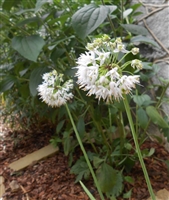 Nodding Wild Onion
Nodding Wild Onion
Allium cernuum
Eye-catching and under-used in the home garden, white-pink globose umbels nod gracefully from arch at the top of the stem. Nectar and pollen primarily attract bees. Grown from KY source seed.
Light: Full to Part Sun
Soil: Moist to Dry
Height: 1.5 feet
Blooms: June-August
Flower Color: White to Pink
Attracts: Butterflies
Deer Resistant

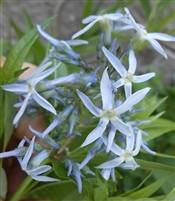 Blue Star
Blue Star
Amsonia tabernaemontana
Enjoy 3-season appeal with true blue flowers in spring and lemony yellow foliage in fall. Especially stunning when a number are planted to form a row or along a building. Deer resistant. Grown from Kentucky-source seed.
Light: Full Sun to Part Shade
Soil: Average
Height: 2 to 4 feet
Blooms: May
Flower Color: Blue

 Columbine
Columbine
Aquilegia canadensis
Columbine is easy to grow and tolerates a wide range of conditions. Red and yellow 1"-2" lantern-shaped flowers are hummingbird magnets. Under favorable conditions Columbine spreads readily. Larval host plant for a cute little butterfly, the Columbine Duskywing. Grown from Kentucky-source seed.
Light: prefers Part Sun
Soil: Moist to Average
Height: 1-2 feet
Blooms: April-June
Flowers: Red with Yellow center

 Swamp Milkweed
Swamp Milkweed
Asclepias incarnata
When looking for a milkweed plant for the home garden, Swamp Milkweed is usually the best fit. It is not stocky nor does it spread vigorously by rhizomes. The milkweeds are one of the best nectar plants to attract pollinators, especially the monarchs which rely on milkweed foliage in the caterpillar stage.
Light: Full Sun
Soil: Moist to Average
Height: to 4 feet
Blooms: June-August
Flowers: Pink

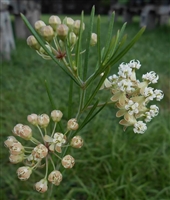 Whorled Milkweed
Whorled Milkweed
Asclepias verticillata
Dainty in appearance with "whorls" of thin leaves and elegant clusters of white flowers. This plant is ideal for that tough spot in dry soil and full sun. Spreads by rhizomes. Larval host to the Monarch butterfly. Grown from Kentucky-source seed.
Light: Full Sun
Soil: Dry
Height: 2 feet
Blooms: July-September
Flowers: White

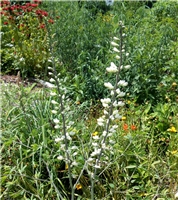 White Wild Indigo
White Wild Indigo
Baptisia alba
Elegant white, pea-shaped flowers displayed along an elongate axis provide cut flowers as early as April. White Wild Indigo is an herbaceous perennial that, in full sun is rounded and bushy but dies back to the ground in winter. Good source of early-season nectar to attract and support our pollinators. Larval host plant for Wild Indigo Duskywing butterfly. Grown from KY source seed.
Light: Full Sun to Part Shade
Soil: Dry to Average
Height: 2 to 4 feet
Blooms: April-May
Flowers: White

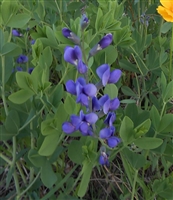 Blue Wild Indigo
Blue Wild Indigo
Baptisia australis
Grown in full sun, forms gorgeous rounded form with blue-green pea-like leaves. Excellent for use in beds & borders and as a cut flower. Larval host plant for the Wild Indigo Duskywing butterfly.
Light: Full Sun to Part Shade
Soil: Average to moist
Height: to 4 feet
Blooms: May-July
Flowers: Purple

 Pale Indian Plantain
Pale Indian Plantain
Cacalia atriplicifolia, Arnoglossum atriplicifolium
Interesting large, fan-shaped leaves are white or "pale" on lower surface. Clusters of cream colored blooms are highly attractive to pollinators. Grown from Kentucky-source seed.
Light: Full to Part Sun
Soil: Average Moisture
Height: 3 to 6 feet
Blooms: July-August
Flower: White-Cream

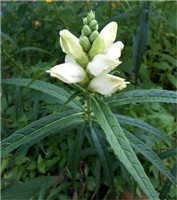 White Turtlehead
White Turtlehead
Chelone glabra
Well sought-after host plant for the Baltimore Checkerspot Butterfly. Blooms are white, sometimes tinged with pink. Perfect plant for a damp spot with intermittent light. Grown from Kentucky-source seed.
Light: Part Sun
Soil: Moist
Height: 2'-4 feet
Blooms: August-October
Flower: White, White & Pink

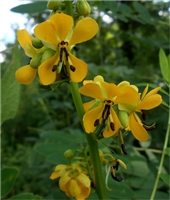 Wild Senna
Wild Senna
Cassia marilandica, Senna marilandica
Topped with dense clusters of yellow pea-like flowers in mid-summer, Wild Senna is low maintenance & deer and rabbit resistance. Although shrubby in habit and therefore also included under "woody" here, it is an herbaceous perennial, sprouting at ground level each spring. Pollinator host plant to Sleepy Orange, Orange-barred Sulfur, Cloudless Sulfur, Silver-spotted Skipper butterflies & the Black Witch moth with wingspan to 7". Grown from Kentucky-source seed.
Light: Full Sun
Soil: Average Moisture
Height: 3-6 feet
Blooms: July-August
Flowers: Yellow

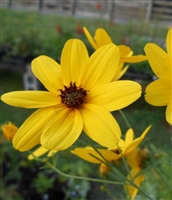 Tall Coreopsis
Tall Coreopsis
Coreopsis tripteris
Tallest Coreopsis topped with delicate flowers that provide food for Goldfinches if allowed to dry and remain into the fall. One larval host plant for the Common Tan Wave Moth and the interesting Wavy-lined Emerald Moth. Plant spreads readily under favorable conditions. Grown from Kentucky-source seed.
Light: Full Sun
Soil: Wet to Dry
Height: 3 to 8 feet
Blooms: July-October
Flowers: Yellow

 Mist Flower
Mist Flower
Conoclinium coelestinum
Lovely accent plant for late-season color and nectar. Excellent for container gardening. For home use, containers or planting in a contained area is recommended as Mist Flower spreads easily. Grown from Kentucky-source seed.
Light: Shade to Full Sun
Soil: Average to Moist
Height: 2 to 3 feet
Blooms: July-November
Flowers: Periwinkle

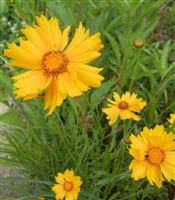 Lance-leaf Coreopsis
Lance-leaf Coreopsis
Coreopsis lanceolata
A tried and true plant for the home garden, Lance-leaf Coreopsis is a prolific bloomer and provides excellent cut flowers.
Light: Full Sun
Soil: Average to Dry
Height: to 2 feet
Blooms: May-July
Flowers: Yellow

 Purple Prairie Clover
Purple Prairie Clover
Dalea purpurea
Purple prairie clover has a deep taproot, making it a good choice for tough, full sun spots prone to drought. Bright, interesting flowers with a long lasting bloom time. Seed is high in protein, a good food source for mammals. A larval host plant for the Dogface Sulfur and Reakirt's Blue butterflies. Grown from Kentucky-source seed.
Light: Full Sun
Soil: Average
Height: 1 to 3 feet
Blooms: June-August
Flowers: Purple

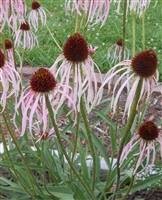 Pale Purple Coneflower
Pale Purple Coneflower
Echinacea pallida simulata
Also known as Glade Coneflower, this plant is elegant with thin reclining petals. It is under-utilized in the home garden and as a cut flower. Attracts bee and butterflies & provides seed for birds if flowering heads remain through winter. Larval host plant for the Silvery Checkerspot butterfly and Wavy-lined Emerald moth. Grown from Kentucky-source seed.
Light: Full Sun
Soil: Average to Dry
Height: to 3 feet
Blooms: June-July
Flowers: Pale Purple to Purple

 Purple Coneflower
Purple Coneflower
Echinacea purpurea
A popular plant for good reason. Blooms attract pollinators in summer and their seed feeds birds in the cold months. Beautiful in a home or business planting and in a vase. One larval host plant for the Silvery Checkerspot butterfly and Wavy-lined Emerald moth. Grown from Kentucky-source seed.
Light: Full Sun
Soil: Average
Height: 1 to 3 feet
Blooms: June-August
Flowers: Purple-Magenta

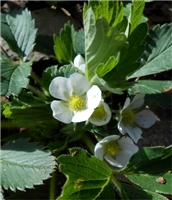 Wild Strawberry
Wild Strawberry
Fragaria virginiana
Wild or Virginia Strawberry has white flowers which provide early-season nectar. Decorative in a hanging pot and effective as a ground cover as it spreads readily by stolons. Having high ecological value, it provides early season nectar, pollen & serves as a larval host plant. Provenance: Kentucky.
Light: Full to Part Sun
Soil: Average
Height: 4 to 7 inches
Blooms: April-June
Flowers: White

 Helen's Flower
Helen's Flower
Helenium autumnale
Also known as Sneezeweed (a misnomer as it is insect pollinated. Pollen is not dispersed via wind), this plant is under-utilized in the home garden and for cut flowers. The flowers have rounded, nearly spherical yellow centers ringed with notched yellow petals. Trim in late June to desired height. A larval host plant for the Dainty Sulfur butterfly. Grown from Kentucky-source seed.
Light: Full to Part Sun
Soil: Average
Height: 3 to 5 feet
Blooms: August-October
Flowers: Yellow

 Purple-headed Sneezeweed
Purple-headed Sneezeweed
Helenium flexuosum
Cute as a button! Unique spherical brown centers are surrounded with reflexed yellow petals. Stems are winged. Great for rain gardens, late-season nectar. Supports an array of bees, wasps, flies and butterflies. One larval host for the Dainty Sulfur butterfly. Grown from KY seed.
Light: Full Sun
Soil: Average to moist
Height: 1 to 3 feet
Blooms: August-October
Flowers: Yellow and Brown

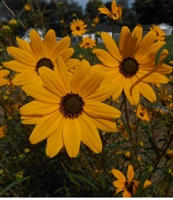 Narrow-leaved Sunflower
Narrow-leaved Sunflower
Helianthus angustifolius
The leaves are very narrow and when in bloom, the plant appears to be a bountiful bouquet. It has a long blooming period. If left standing, the dried seeds support many birds in winter. Under favorable conditions, this plant grows large and spreads readily. Grown from Kentucky-source seed.
Light: Full Sun
Soil: Average to Moist
Height: 3 to 6 feet
Blooms: July-August
Flowers: Yellow

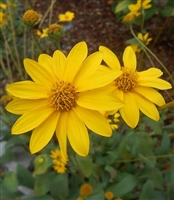 Few-leaved Sunflower
Few-leaved Sunflower
Helianthus occidentalis
Most of the leaves are clustered in a basal rosette making the flowering stems look airy and perfect to trim and pop into a vase. Like other sunflowers seed heads left on drying fall stems will provide food for birds in winter. Visited by a multitude of pollinators and is one larval host for the Gorgone Checkerspot, Silvery Checkerspot and Painted Lady butterflies.
Light: Full Sun
Soil: Dry to Average
Height: 2 to 4 feet
Blooms: August-September
Flowers: Yellow

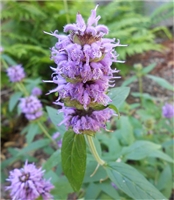 Downy Wood Mint
Downy Wood Mint
Blephilia ciliata
Under-used in home gardens, Downy Wood Mint tolerates a wide range of conditions, is of short stature, provides early season color and fall foliage can present various shades of pink. Also known as Pagoda Plant, this is a wonderful nectar plant for bees. Deer resistant. Grown from Kentucky-source seed.
Light: Light Shade
Soil: Average to Dry
Height: 1-2 feet
Blooms: May-July
Flowers: Light Purple

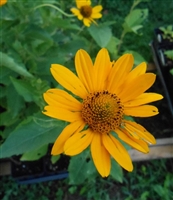 Oxeye Sunflower
Oxeye Sunflower
Heliopsis helianthoides
Beautiful orange-yellow flowers practically glow and will continue to bloom when spent flowers are removed. Variously called Oxeye Sunflower, Early Sunflower, Everlasting Sunflower, & False Sunflower.
Light: Full Sun
Soil: Average to Dry
Height: 3 to 5 feet
Blooms: June-August
Flowers: Orange-Yellow

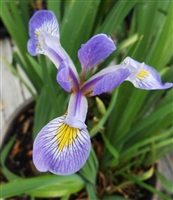 Southern Blue Flag Iris
Southern Blue Flag Iris
Iris virginica
Plant with sword-like leaves and large blue-violet flowers (1-3 cm across) is also well-rooted to help prevent erosion in low areas. Best grown in consistently moist organic soils. Good candidate for a rain garden.
Light: Full Sun
Soil: Moist-Wet
Height: 1 to 3 feet
Blooms: June
Flowers: Blue-Violet with Yellow

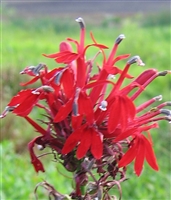 Cardinal Flower
Cardinal Flower
Lobelia cardinalis
Truly stunning carmine flowers borne on tall slender spikes which rise from a basal rosette of leaves. Ideal for use in hummingbird and rain gardens. Grown from Kentucky-source seed.
Light: Full Sun
Soil: Moist-Wet
Height: 2 to 4 feet
Blooms: July-September
Flowers: Red

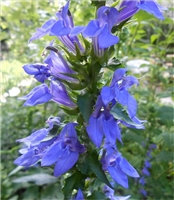 Great Blue Lobelia
Great Blue Lobelia
Lobelia siphilitica
Spikes of tubular blue-violet flowers attract and support bumblebees. This plant works well in a rain garden, along a waterway or at the edge of a pond. Grown from Kentucky-source seed.
Light: Full Sun to Part Shade
Soil: Moist to Wet
Height: 2 to 4 feet
Blooms: July-September
Flowers: Blue-violet

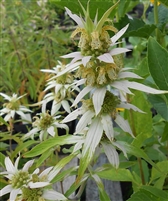 Spotted Beebalm
Spotted Beebalm
Monarda punctata
Showy pagoda-like white to deep pink bracts form a ring below less conspicuous spotted yellow flowers. Low maintenance, long-lasting bloom period, though a 'weak perennial' but may self-seed. A pollinator favorite.
Light: Part to Full Sun
Soil: Average to Dry
Height: 1 to 3 feet
Blooms: July-September
Flowers: Yellow, White-Pink Bracts

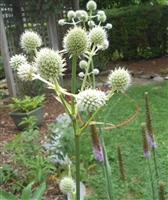 Rattlesnake Master
Rattlesnake Master
Eryngium yuccifolium
Rattlesnake Master is surprisingly a member of the Carrot Family. Spherical flower clusters add much interest to a garden or a bouquet. Larval host to an attractive moth, the Rattlesnake Master Borer. Drought-tolerant. Grown from Kentucky-source seed.
Light: Full Sun
Soil: Dry to Average
Height: 4 to 5 feet
Blooms: June-September
Flowers: Green

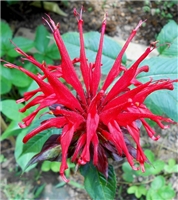 Scarlet Beebalm
Scarlet Beebalm
Monarda didyma
Brilliant red flowers are a hit with hummingbirds. Foliage emits spicy odor when crushed. Striking as a cut flower. Not native to Kentucky but to neighboring states, both Ohio and Tennesse.
Light: Full Sun to Part Shade
Soil: Average to Wet
Height: 2 to 4 feet
Blooms: July-August
Flowers: Red

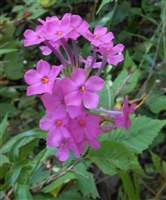 Garden Phlox
Garden Phlox
Phlox paniculata
True to it's name, Garden Phlox does well in the home garden and in rain gardens. Best planted in full sun. It is an excellent source of nectar for hummingbirds.
Light: Full Sun to Part Shade
Soil: Average
Height: 2 to 4 feet
Blooms: July-September
Flowers: Pink-Purple
